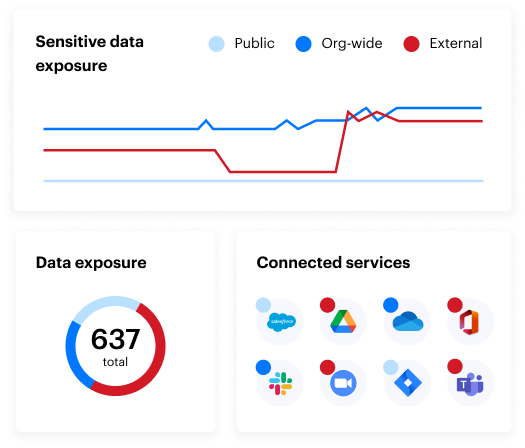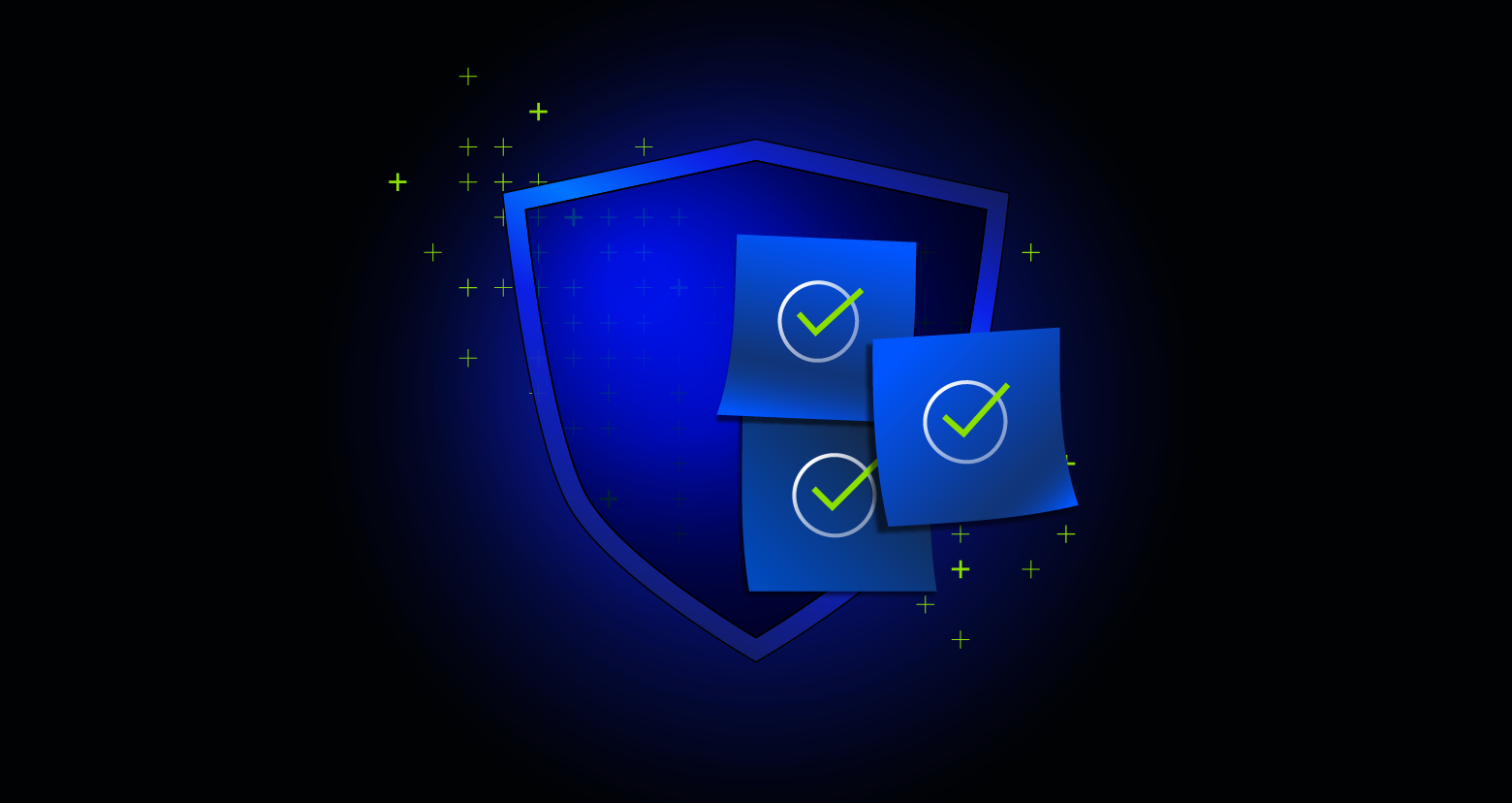The power and scale of modern organizational data gives teams the edge to think quickly and drive better business outcomes. However, distributed data across multiple platforms can create visibility gaps and security vulnerabilities.
In this article, we’ll break down the most critical aspects of data security strategies and how you can address them before incidents occur.
By implementing these elements, organizations can significantly improve their data security posture while reducing their risk of a breach and maintaining regulatory compliance.
Understanding the data security landscape
Sensitive information is often stored across several platforms; Microsoft 365, Google Workspace, AWS and Azure are just a few areas where your organization can store sensitive data.
This complexity creates its own set of challenges:
- Lack of visibility: The spread of data makes it difficult to determine where sensitive information resides
- Monitoring permissions: Access patterns can be challenging to track across disparate systems
- Ensuring consistency: Each environment works differently, making it difficult to maintain consistent security policies and regulatory compliance
- Increased attack surfaces: Expanding cloud adoption inherently expands the number of publicly accessible endpoints, not to mention the potential of misconfigurations and complexity in IAM.
Until a comprehensive assessment is performed, organizations that lack visibility are left unaware of their data risk exposure.
Key elements of a data security strategy
Complete data discovery and classification
Protecting your sensitive data becomes impossible without full visibility over your estate.
A comprehensive data discovery and classification solution should:
- Scan both structured and unstructured repositories continuously
- Identify sensitive data according to regulatory frameworks such as GDPR, HIPAA, PCI or SOX
- Provide real-time visibility
- Keep classification updated as data is created or modified
Having a complete picture of where your critical data is, gives your team the ability to manage risk, effectively control access and respond to threats as they arise.
Insight into overprivileged users
While it’s important to monitor external threats, with employees, contractors, and other insiders, especially when their permissions are extensive, also present serious risks to data.
Maybe a well-meaning employee downloads sensitive data to an unsecured device, or a disgruntled insider is looking to exfiltrate data; regardless, over-privileged users create significant exposure.
To reduce insider threats and access misuse, organizations should:
- Limit user access to what is necessary for their functions
- Regularly audit and revoke excessive or outdated permissions
- Use threat detection solutions, such as UEBA, to monitor abnormal user behavior
- Set up alerts for unusual activity tied to sensitive files or systems
SaaS and third-party integrations
Third-party apps are integral to daily workflows and are often connected to sensitive data.
However, most organizations haven’t audited the data these apps can access, how they’re configured, or whether they have current users. In some cases, OAuth is granted once and forgotten about, creating a hidden vulnerability in its unmanaged access.
Many SaaS providers operate on a shared responsibility model, where the SaaS provider is responsible for securing the infrastructure and providing a highly available solution, while the consumer is responsible for protecting their own data. The misunderstanding of who is responsible for data protection can lead to ineffective security practices.
Without consistent oversight, attackers can use third-party apps as a backdoor into your environment.
To avoid these risks, organizations should:
- Continuously audit connected apps across your environment
- Review and manage OAuth permissions and API tokens regularly
- Remove unused or over-permissive integrations
- Apply data access controls and audit logging to all third-party connections

Automated remediation and prevention
Many data security strategies tend to focus on detection. However, automated remediation and prevention are extremely important in keeping critical information secure. Once you have visibility into your data, you have to have a way to remediate issues that doesn’t overburden your security team.
As organizations scale their volume of data, it becomes harder to remediate issues quickly, let alone manually. Automation eases this burden.
Solutions with automated prevention should:
- Automatically revoke excessive permissions.
- Remove unnecessary sharing links and public access.
- Continually prune stale user accounts and dated permissions.
- Automatically label and protect sensitive data.
Automating your data security shifts your organization from reactive firefighting to proactive, scalable defense.
Data-centric user behavior analytics
Traditionally, security monitoring focuses on network activity and endpoint protection.
Most organizations overlook the power of data-centric user and entity behavior analytics (UEBA), which analyzes user behavior to identify threats and compromised accounts.
Effective UEBA should:
- Establish baseline behavior for each user's data access patterns.
- Detect anomalous data access or unusual download activities.
- Identify potential account compromise or insider threats.
- Correlate user activities across different data repositories.
Read our UEBA Buyer’s Guide to learn more.
Unified cross-platform protection
As organizations implement point solutions for different environments, new security silos are potentially opened. Avoiding this means implementing a unified security approach that works consistently across all data repositories.
An effective unified approach protects data across:
- Cloud storage services: AWS S3, Azure Blob Storage, Box
- Collaboration platforms: Microsoft 365, Google Workspace
- Traditional file systems and NAS devices: Windows File Servers, NetApp FAS
- Databases and data warehouses: BigQuery, Amazon Redshift
- Email systems: Microsoft Exchange, Gmail
- Specialized applications: Salesforce, MongoDB, Snowflake
A truly unified approach to security ensures consistent enforcement of security policies, regardless of where the data is located or how it’s accessed.
Continuous monitoring and auditing
Many organizations overlook the importance of continuous monitoring and having detailed audit trails in favor of other methods, like point-in-time security assessments. However, these assessments only provide a snapshot of your security posture during a given time frame. With data constantly growing, your solution should take the new information into account.
An effective solution that continuously monitors your data estate should:
- Track data access events in real-time
- Maintain searchable audit logs of user interactions with sensitive data
- Alert you to any policy violations or suspicious activities
- Support investigation and forensic analysis with detailed event data
Effective data security means gaining a full picture of your environment. Continuous monitoring and auditing ensure that no critical event goes unnoticed.
AI-enhanced threat detection
While there are risks AI tools can bring to your organization, the risks AI tools bring, the power AI can bring to cybersecurity is nothing short of groundbreaking.
Many traditional security approaches struggle with the volume and complexity of modern data environments. However, AI-enhanced security solutions enable organizations to identify subtle patterns and correlations that human analysts might miss.
AI-enhanced data security tools should:
- Correlate events across multiple platforms and time periods
- Identify complex attack patterns that simple rule-based systems miss
- Reduce false positives through contextual understanding
- Provide actionable alerts with supporting evidence
Did you know that 99% of organizations have sensitive information exposed to AI? Discover more in our 2025 State of Data Security Report, where we share insights from our analysis of 1,000 real-world IT environments.
Common issues that create data security gaps
Even with substantial financial support, security programs can struggle if governance is not clearly defined. A robust data security strategy goes beyond the technology involved —accountability, ownership, and cross-functional alignment are essential for its success.
Here are three of the most common governance missteps that can quietly erode your security posture:
Lack of clear data ownership
Modern organizations struggle with assigning clear responsibility for data, especially in complex environments where data lives across SaaS apps, cloud storage and legacy systems. Without a clear understanding of who owns a particular piece of data, it’ll likely remain unprotected.
Teams without explicit ownership leave these questions unanswered:
- Who should have access?
- How long should it be retained?
- What are the compliance requirements?
To eliminate ambiguity, assigning data stewards and implementing role-based access ownership is essential. This ensures data doesn’t fall through the cracks.
Security silos between teams
Many security teams remain isolated from the teams who build, deploy, and use data-driven applications. Despite this, effective security is not a one-team job.
Serious risk can arise from situations like developers pushing code without security reviews or analysts exporting sensitive data to unmanaged tools. This leaves security teams chasing incidents with limited visibility into their context.
To address the fragmented security posture created by these situations, organizations should embed security champions within engineering teams, establish shared KPIs, and foster a culture of cross-team accountability.
Reactive vs. proactive security posture
Organizations that merely respond to incidents after they happen tend to play catch-up instead of proactively identifying and addressing all potential attack vectors before they can be exploited.
To ensure threats are detected before it’s too late, organizations need:
- Ongoing risk assessments
- Regular policy reviews
- Visibility into how data is actually used
A proactive security posture means adopting continuous monitoring, implementing automated alerts for risky behavior and routinely reassessing access and exposure, not just during audits or breach investigations.
Building a comprehensive data security strategy
To review what’s been shared, your data security strategy needs the following to be effective:
- Complete data visibility: Continuous discovery and classification of sensitive data across all repositories
- Risk-based security posture: Understand where sensitive data resides and who has access to it
- Automated remediation: Implement automated fixes for common security issues to mitigate alert fatigue and manual work
- Proactive detection: Combine data-centric UEBA with AI-enhanced analytics to identify threats before they cause damage
- Unified protection framework: Implement consistent security controls across all data repositories
- Continuous validation: Regularly test security controls to validate the effectiveness of your security strategy
With these measures in place, your security team can rest easy knowing your defenses are always one step ahead of emerging threats.
Close data security gaps with Varonis
Varonis is designed to enhance your data security strategy, without needing additional manual effort from your team.
Our platform proactively reduces risk by automatically locating and classifying sensitive data across your environment, addressing any issues it detects, and alerting security teams to any unusual behavior it identifies when necessary.
Varonis has taken a lot of the manual work out of everything. It’s basically like having another member of the team to constantly watch our data. Classification, clean-up and ongoing use of this product have saved us countless hours of work.
Shane Barry, IT Security Manager, Pizza Express
With Varonis, you can:
- Continuously discover and classify sensitive data across AWS, Azure, Google Cloud, and more
- Detect shadow data and misconfigurations before they become breaches
- Enforce least-privilege access automatically and remediate excessive permissions
- Monitor data activity and access patterns in real time
- Simplify compliance reporting for regulations like GDPR, HIPAA, and CCPA
Looking to uncover hidden risks and blind spots in your data estate? Get started with our free Data Risk Assessment today.
What should I do now?
Below are three ways you can continue your journey to reduce data risk at your company:
Schedule a demo with us to see Varonis in action. We'll personalize the session to your org's data security needs and answer any questions.
See a sample of our Data Risk Assessment and learn the risks that could be lingering in your environment. Varonis' DRA is completely free and offers a clear path to automated remediation.
Follow us on LinkedIn, YouTube, and X (Twitter) for bite-sized insights on all things data security, including DSPM, threat detection, AI security, and more.








